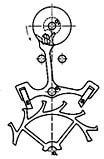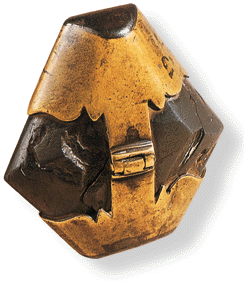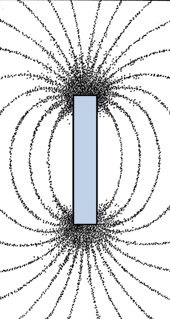
 PRECISION WATCH REPAIR BY CHARLIE SQUIRES
PRECISION WATCH REPAIR BY CHARLIE SQUIRES
| Question:
Recently my watch began reading time in a most bizarre way. Someone told me it might be magnetized. What does this mean and how could it have happened? Oscar Peterson, Oxford, England
Answer by Professor J.C. Nicolet A bit of history The phenomenon of magnetism was first observed by the Greeks about 600 B.C. The natural magnet Fe3O4 (a black ferrous oxide), called magnetite was found in the province of Magnesia in Turkey. Around the 3rd Century A.D., the Chinese used magnetic material found in nature to make their compasses so necessary in navigating the high seas. In 1600, William Gilbert, physician to England's Queen Elizabeth I, published a treatise called "De Magnete" which theorized that the earth was one gigantic magnet, thus explaining variations in the movement of needles that had been magnetized.
Artificial magnetism Magnetic fields produced by natural magnets are too weak to disturb the operation of a watch. The same is not true, however, of man-made magnetic fields. In the early 19th Century, when scientists discovered how to produce very large electric currents, strong magnetic fields appeared by electromagnetic inductance. This important physical phenomenon was discovered in 1831 by Faraday, and began the development of important practical applications of electricity, i.e. electric motors, current generators, telegraph, telephone, radios, etc. In 1872, Siemens produced the first really efficient electric motors, and over the next 30 years, these new inventions quickly found their way into small workshops wherever electricity was available. By the end of the 19th Century, the widespread use of electric motors brought with it the widespread magnetization of pocket watches. The first "victims" of this artificial magnetism were people employed in factories using electricity. The early current generators caused the formation of strong magnetic fields which had a negative effect on any watches worn in the workplace. A solution to this problem arrived in the form of an apparatus composed of a horseshoe-shaped magnet that could be turned by means of a crank. At each half-turn, the polarity of the magnetism at any given point changed direction. By alternatively moving the magnetized object towards the horseshoe and then away from it, the article could be demagnetized. (This same principle is used today except that the horseshoe has been replaced by a powerful coil connected to an alternating current.)
Early preventive measures In the 19th Century, the regulating organs of watches were made essentially of steel thus making them highly susceptible to the effects of magnetic fields. The first measures to prevent this problem consisted of placing pocket watches in empty waxed white iron boxes which conducted the magnetic forces. While these waxed boxes were very efficient in protecting the watches, their main drawback was that they had to be opened to tell the time. The first quarter of the 20th Century brought about significant changes in this domain. The 1920 Nobel prize winner, Charles-Edouard Guillaume of Fleurier, Switzerland invented a nickel-iron alloy which replaced the earlier steel alloy in making balance springs. This greatly improved the reliability of watches for three reasons: · They were less sensitive to magnetism. · They were less sensitive to rust due to humidity. · They were less sensitive to thermal changes (which was the principal aim of Guillaume's research). With this alloy and the invention of stainless steel used in making cases, watches were no longer susceptible to the effects of magnetism in the home or in normal industrial workplaces. And gold? Unlike their steel cousins, watch cases made from gold do not protect the watch from the effects of magnetism. It is therefore advisable to equip the movements of these timekeepers with a para-magnetic screen made of iron, mu-metal or permalloy. This precaution is usually not taken for esthetic reasons. A gold watch with a protective screen is not very elegant, making it more difficult to sell. Perhaps one day, manufacturers will look more closely at this problem. In the meantime, wearers of gold watches should be careful not to expose their timepieces to magnetic fields. Magnetic fields in the home So where are the risks of these forces in the home? Non-negligible magnetic fields are found near loudspeakers, stereo systems, televisions and radios. Therefore, one should avoid setting a gold watch on top of any of these items. Less obvious, but posing an even greater danger for a gold watch are the magnets found in refrigerator doors or other cabinets. Even a brief contact with these items is enough to magnetize a gold watch. Caution is the byword when wearing one of these timekeepers in the kitchen. Although a magnetized watch can be demagnetized as mentioned above, the procedure is tedious. To do a good job, the watch must be dismantled and each steel part demagnetized separately. |
||||

